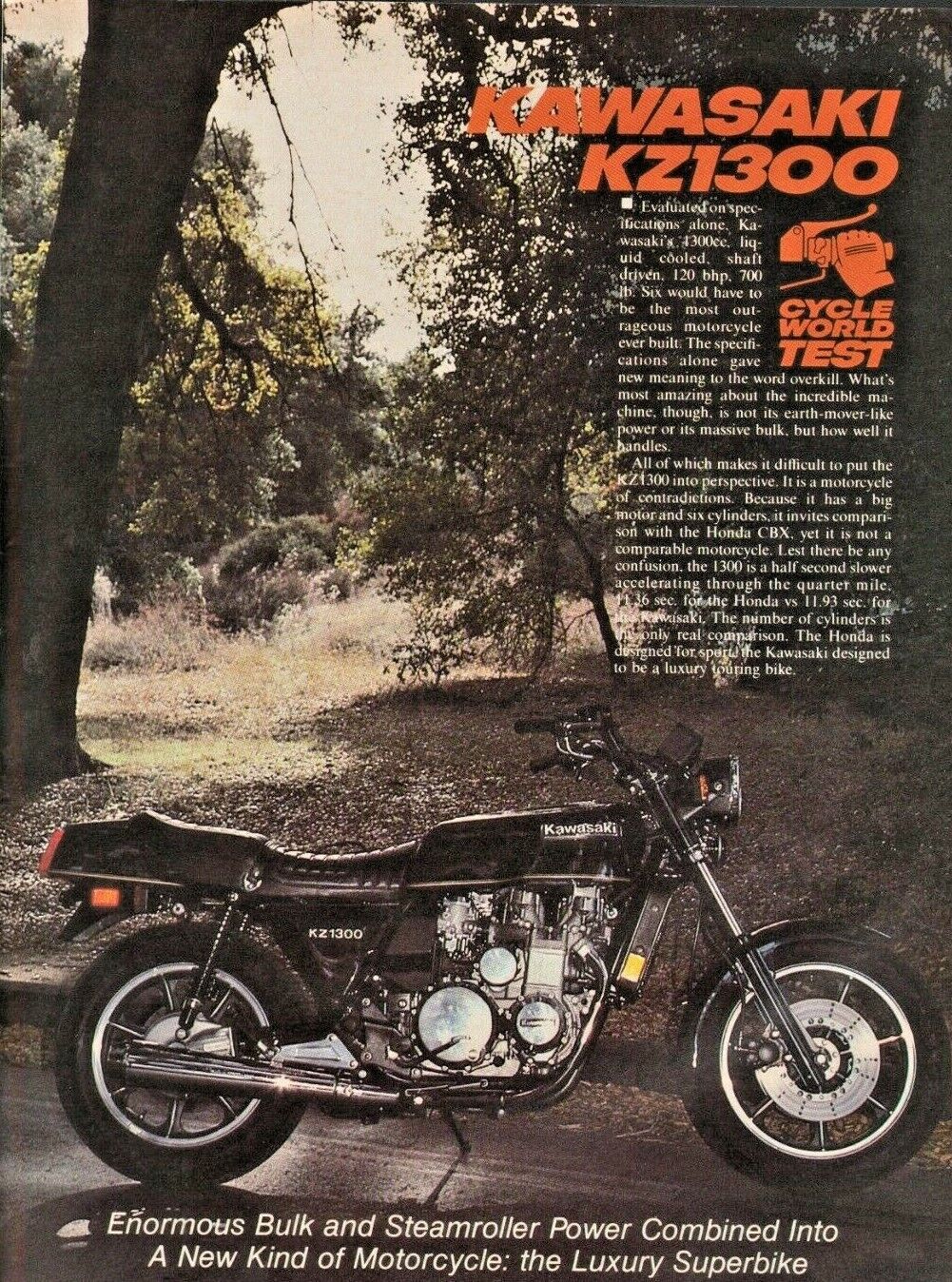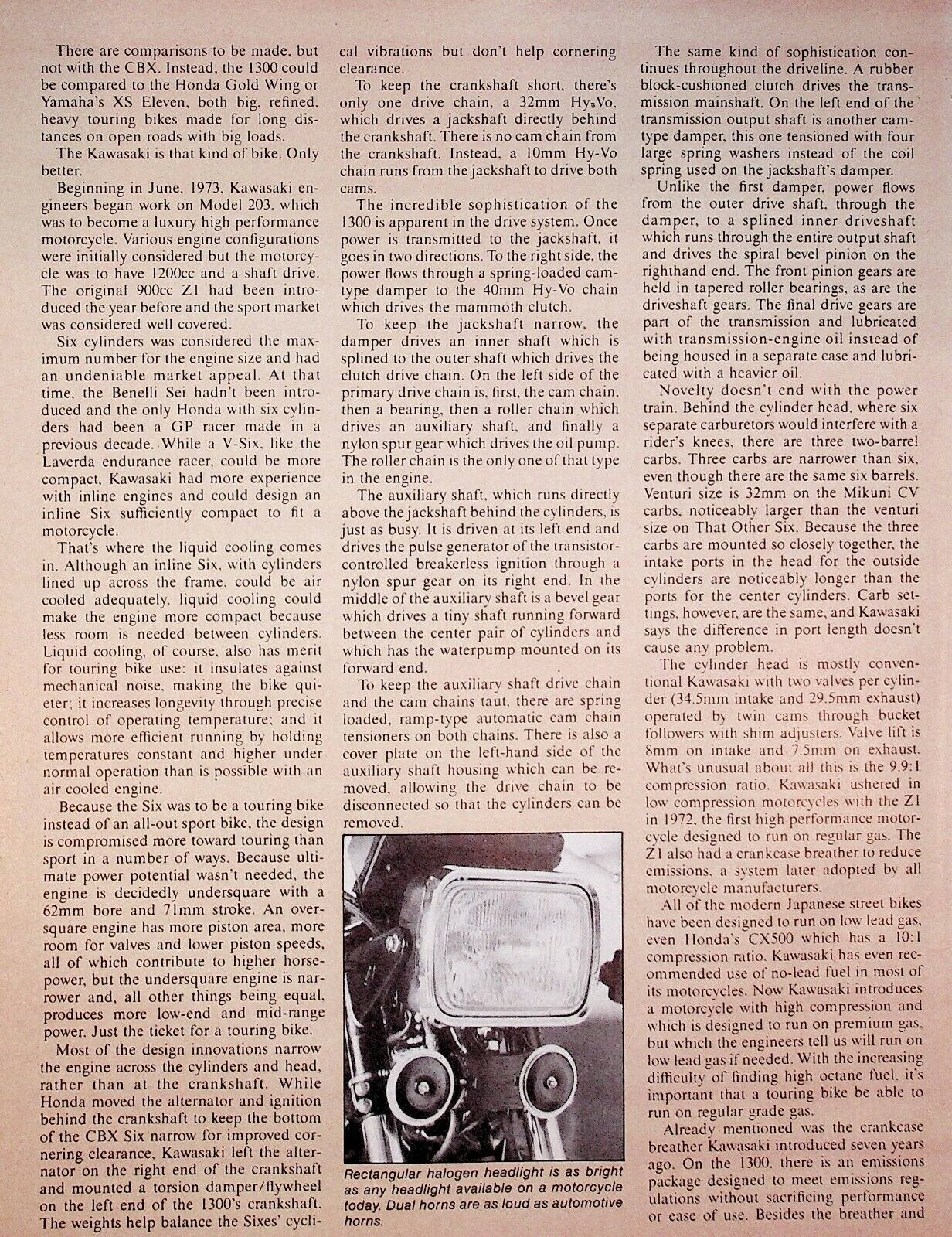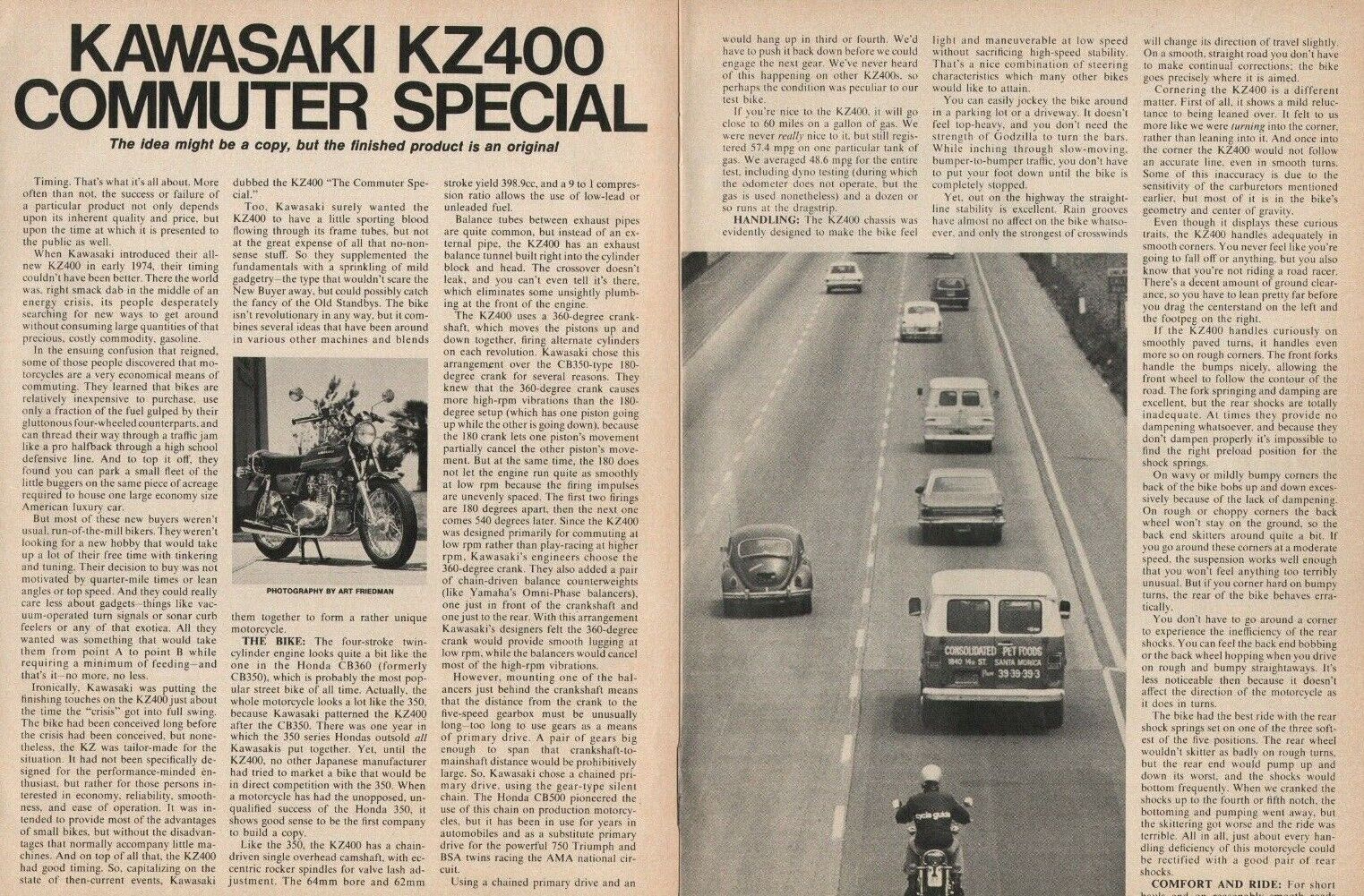-40%
1979 Kawasaki KZ1300 - 8-Page Vintage Motorcycle Road Test Article
$ 7.37
- Description
- Size Guide
Description
1979 Kawasaki KZ1300 - 8-Page Vintage Motorcycle Road Test ArticleOriginal, vintage magazine article
Page Size: Approx. 8" x 11" (21 cm x 28 cm) each page
Condition: Good
...
There are comparisons to be made, but
not with the CBX. Instead, the 1300 could
be compared to the Honda Gold Wing or
Yamaha’s XS Eleven, both big, refined,
heavy touring bikes made for long dis-
tances on open roads with big loads.
The Kawasaki is that kind of bike. Only
better.
Beginning in June, 1973, Kawasaki en-
gineers began work on Model 203. which
was to become a luxury high performance
motorcycle. Various engine configurations
were initially considered but the motorcy-
cle was to have 1200cc and a shaft drive.
The original 900cc Z1 had been intro-
duced the year before and the sport market
was considered well covered.
Six cylinders was considered the max-
imum number for the engine size and had
an undeniable market appeal. At that
time, the Benelli Sei hadn’t been intro-
duced and the only Honda with six cylin-
ders had been a GP racer made in a
previous decade. While a V-Six. like the
Laverda endurance racer, could be more
compact, Kawasaki had more experience
with inline engines and could design an
inline Six sufficiently compact to fit a
motorcycle.
That's where the liquid cooling comes
in. Although an inline Six. with cylinders
lined up across the frame, could be air
cooled adequately, liquid cooling could
make the engine more compact because
less room is needed between cylinders.
Liquid cooling, of course, also has merit
for touring bike use: it insulates against
mechanical noise, making the bike qui-
eter; it increases longevity through precise
control of operating temperature; and it
allows more efficient running by holding
temperatures constant and higher under
normal operation than is possible with an
air cooled engine.
Because the Six was to be a touring bike
instead of an all-out sport bike, the design
is compromised more toward touring than
sport in a number of ways. Because ulti-
mate power potential wasn't needed, the
engine is decidedly undersquare with a
62mm bore and 71mm stroke. An over-
square engine has more piston area, more
room for valves and lower piston speeds,
all of which contribute to higher horse-
power, but the undersquare engine is nar-
rower and, all other things being equal,
produces more low-end and mid-range
power. Just the ticket for a louring bike.
Most of the design innovations narrow
the engine across the cylinders and head,
rather than at the crankshaft. While
Honda moved the alternator and ignition
behind the crankshaft to keep the bottom
of the CBX Six narrow for improved cor-
nering clearance, Kawasaki left the alter-
nator on the right end of the crankshaft
and mounted a torsion damper/flywheel
on the left end of the 1300’s crankshaft.
The weights help balance the Sixes’ cycli-
cal vibrations but don’t help cornering
clearance.
To keep the crankshaft short, there’s
only one drive chain, a 32mm Hy0Vo.
which drives a jackshaft directly behind
the crankshaft. There is no cam chain from
the crankshaft. Instead, a 10mm Hy-Vo
chain runs from the jackshaft to drive both
cams.
The incredible sophistication of the
1300 is apparent in the drive system. Once
power is transmitted to the jackshaft, it
goes in two directions. To the right side, the
power flows through a spring-loaded cam-
type damper to the 40mm Hy-Vo chain
which drives the mammoth clutch.
To keep the jackshaft narrow, the
damper drives an inner shaft which is
splined to the outer shaft which drives the
clutch drive chain. On the left side of the
primary drive chain is. first, the cam chain,
then a bearing, then a roller chain which
drives an auxiliary shaft, and finally a
nylon spur gear which drives the oil pump.
The roller chain is the only one of that type
in the engine.
The auxiliary shaft, which runs directly
above the jackshaft behind the cylinders, is
just as busy. It is driven at its left end and
drives the pulse generator of the transistor-
controlled breakerless ignition through a
nylon spur gear on its right end. In the
middle of the auxiliary shaft is a bevel gear
which drives a tiny shaft running forward
between the center pair of cylinders and
which has the waterpump mounted on its
forward end.
To keep the auxiliary shaft drive chain
and the cam chains taut, there are spring
loaded, ramp-type automatic cam chain
tensioners on both chains. There is also a
cover plate on the left-hand side of the
auxiliary shaft housing which can be re-
moved. allowing the drive chain to be
disconnected so that the cylinders can be
removed.
Rectangular halogen headlight is as bright
as any headlight available on a motorcycle
today. Dual horns are as loud as automotive
horns.
The same kind of sophistication con-
tinues throughout the driveline. A rubber
block-cushioned clutch drives the trans-
mission mainshaft. On the left end of the
transmission output shaft is another cam-
type damper, this one tensioned with four
large spring washers instead of the coil
spring used on the jackshaft's damper.
Unlike the first damper, power flows
from the outer drive shaft, through the
damper, to a splined inner driveshaft
which runs through the entire output shaft
and drives the spiral bevel pinion on the
righthand end. The front pinion gears are
held in tapered roller bearings, as are the
driveshaft gears. The final drive gears are
part of the transmission and lubricated
with transmission-engine oil instead of
being housed in a separate case and lubri-
cated with a heavier oil.
Novelty doesn't end with the power
train. Behind the cylinder head, where six
separate carburetors would interfere with a
rider’s knees, there are three two-barrel
carbs. Three carbs are narrower than six,
even though there are the same six barrels.
Venturi size is 32mm on the Mikuni CV
carbs, noticeably larger than the venturi
size on That Other Six. Because the three
carbs are mounted so closely together, the
intake ports in the head for the outside
cylinders are noticeably longer than the
ports for the center cylinders. Carb set-
tings, however, are the same, and Kawasaki
says the difference in port length doesn't
cause any problem.
The cylinder head is mostly conven-
tional Kawasaki with two valves per cylin-
der (34.5mm intake and 29.5mm exhaust)
operated by twin cams through bucket
followers with shim adjusters. Valve lift is
8mm on intake and 7.5mm on exhaust.
What's unusual about all this is the 9.9:1
compression ratio. Kawasaki ushered in
low compression motorcycles with the Z1
in 1972. the first high performance motor-
cycle designed to run on regular gas. The
Zl also had a crankcase breather to reduce
emissions, a system later adopted by all
m o t o rcycl e m a n u fa c t u re rs.
All of the modern Japanese street bikes
have been designed to run on low lead gas,
even Honda's CX500 which has a 10:1
compression ratio. Kawasaki has even rec-
ommended use of no-lead fuel in most of
its motorcycles. Now Kawasaki introduces
a motorcycle with high compression and
which is designed to run on premium gas.
bin which the engineers tell us will run on
low lead gas if needed. With the increasing
difficulty of finding high octane fuel, it's
important that a touring bike be able to
run on regular grade gas.
Already mentioned was the crankcase
breather Kawasaki introduced seven years
ago. On the 1300. there is an emissions
package designed to meet emissions reg-
ulations without sacrificing performance
or ease of use. Besides the breather and...
13979-AL-7904-08










